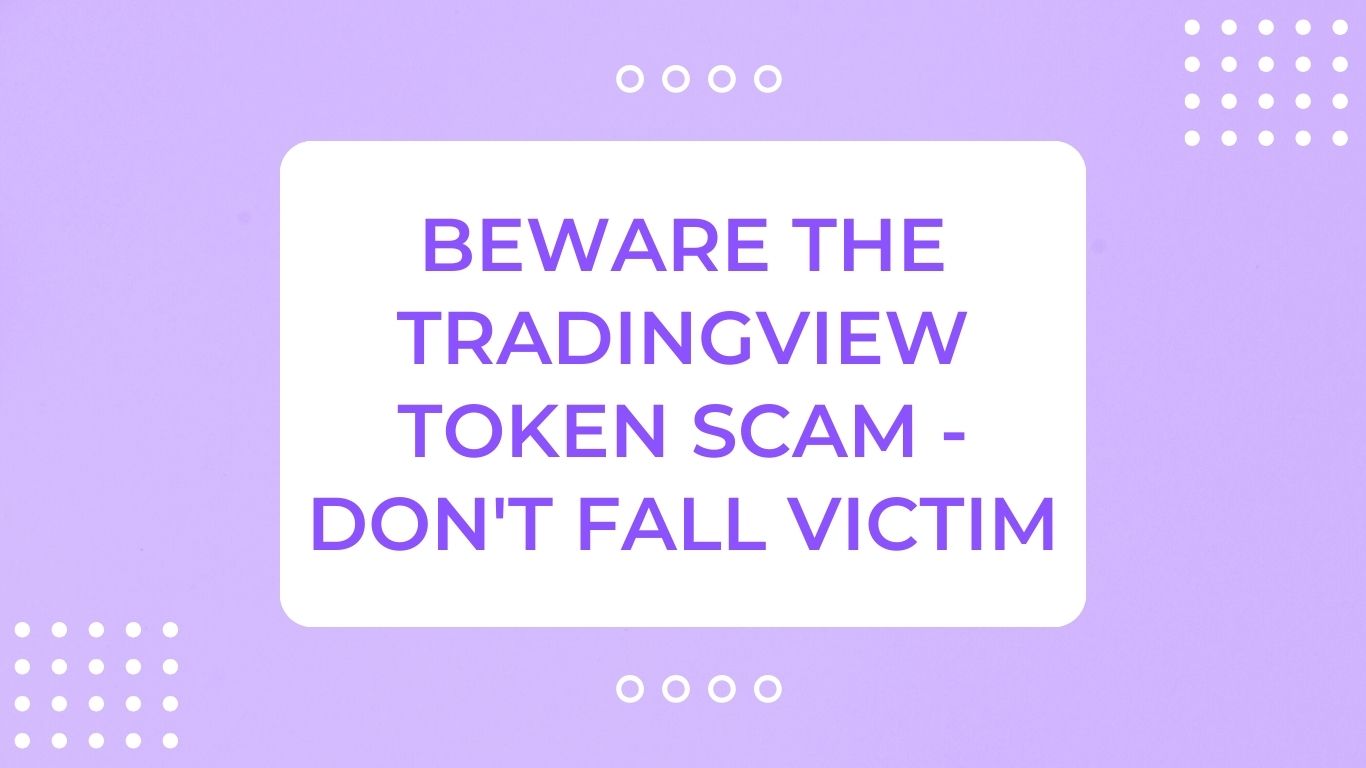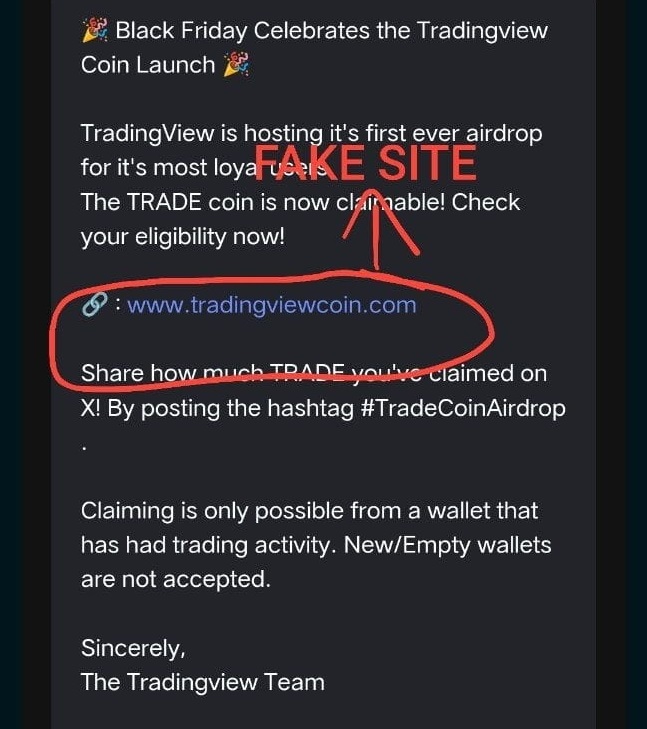The recent proliferation of scam tokens and fraudulent airdrops has put crypto users on high alert. One of the latest and most concerning examples is the “TradingView token” scam. This guide will provide a detailed breakdown of how the scam operates, how to identify fraudulent airdrops, and most importantly, how users can protect themselves.
What is the TradingView Token Scam?
The TradingView token scam revolves around phishing emails and fake websites promoting a non-existent “TradingView Coin” airdrop. Scammers send emails pretending to be from TradingView, claiming the platform is launching its own token called “TRADE” and is airdropping free coins to users.
The emails contain links to fake TradingView sites asking users to connect their crypto wallets to claim the airdrop. If users connect, the scammers can steal funds and access accounts.
The scam exploits TradingView’s brand recognition and the hype around airdrops to trick unsuspecting users. However, TradingView has not actually launched any token – the airdrop is completely fake.
Email and Website Red Flags
While the scam emails try to mimic official TradingView website communications, there are some clear red flags:
🚩 Sender address – While scammers spoof the “[email protected]” address, the actual sender address is different. Carefully check the email header.
🚩 Domain name – The fake airdrop sites use domain names like “tradingviewtoken.com” instead of “tradingview.com”.
🚩 Registration dates – Fake sites will have recent registration dates, unlike the long-standing official domain.
🚩 Spelling/grammar errors – Phishing content often contains typos, bad grammar and formatting issues.
🚩 Request to connect wallet – Official companies will never ask users to connect wallets to external sites for airdrops.
🚩 No mention on TradingView’s official channels – There are no announcements about an airdrop on TradingView’s real website, blog or social media.
Anatomy of the Scam
The TradingView token scam exhibits many typical phishing campaign tactics:
✔️ Impersonating a known brand – Using the TradingView name and trademark builds trust.
✔️ Exploiting FOMO – The idea of a limited-time airdrop from a major platform creates fear of missing out.
✔️ Eye-catching subject lines – Subjects like “Claim your free TRADE tokens!” grab attention.
✔️ Appealing to loyalty – Language like “our most loyal users” makes targets feel special and recognized.
✔️ Faking urgency – Saying the airdrop is “claimable now” pressures users to act quickly.
✔️ Requesting wallet access – This is the key to stealing funds; no legitimate airdrop would do this.
✔️ Spreading on social media – Scammers use fake accounts to post about the airdrop and lend credibility.
Who is Behind the Scam?
It is unclear exactly who is orchestrating the TradingView token scams, but it is likely an organized group of cybercriminals. Possible suspects include:
Phishing kit creators – Developers who make phishing kits could be customizing them for TradingView.
Telegram bot networks – Bots on Telegram are used to promote fake airdrops.
Giveaway scammers – Groups running fake crypto giveaways could also be deploying phishing sites.
Nigerian cybercrime rings – West African fraud networks are heavily involved in crypto scams.
Eastern European hackers – Many phishing attacks originate from Russia and neighboring countries.
APT groups – State-sponsored hackers could be experimenting with crypto phishing.
However, the true culprits cover their tracks using anonymity tools, so attribution is very difficult. The important thing is recognizing how the scam operates so you can avoid becoming a victim.
Recent Examples of the TradingView Token Scam
While TradingView token scams were rare a few months ago, they have proliferated rapidly across social media and email in recent weeks. Some prime examples include:
Reddit – Several Reddit users reported receiving phishing emails promoting TRADE tokens. The emails used the [email protected] sender name to appear legitimate.
Twitter – Scam accounts posted tweets claiming TradingView was airdropping tokens and urging users to visit fake phishing links.
YouTube – YouTube live streams have broadcast fake TradingView giveaways, enticing viewers to connect wallets on fraudulent sites.
Telegram – Messaging bots on Telegram channels have spread links to fake TradingView airdrop sites.
Discord – Discord servers focused on TradingView have seen users receive and share scam links.
These examples demonstrate how aggressively scammers are exploiting TradingView’s brand on all major social platforms.
Who is Being Targeted?
The attackers behind the TradingView token scams appear to be targeting:
Active TradingView users – Those who use TradingView regularly are most familiar with the brand and more likely to trust emails and sites appearing to come from the platform.
Airdrop chasers – Users who hunt for airdrops across social media are highly sought after targets since they are eager to participate in free token distributions.
New crypto users – Those just entering the crypto space may be unfamiliar with phishing techniques and how to identify fraudulent airdrops.
Trading groups – Active trading communities like subreddits, Discord servers and Telegram channels are hotbeds for spreading fake airdrops.
YouTubers/influencers – Scammers target major YouTube and Twitter accounts to reach their large followings with fake promotions.
Essentially anyone familiar with TradingView or interested in crypto airdrops could be a target. Scammers cast a wide net across social media to ensnare as many victims as possible.
How to Identify Fraudulent Airdrops
While the TradingView scam is just one example, many fraudulent airdrops follow similar patterns. Here are some tips for spotting fake airdrops:
- Research the company – Check the website and social media of any company promoting an airdrop to confirm it is legitimate.
-
Look for official announcements – Reputable companies will promote airdrops on their official channels, not just random third-party sites.
-
Evaluate the website – Fake airdrop sites often have new domain registrations and grammatical errors.
-
Examine the token contract – Search for the token address on blockchain explorers to uncover suspicious smart contracts.
-
Beware “urgent” claims – Pressure to act quickly is a red flag – real airdrops don’t require immediate action.
-
Never connect your wallet – No legitimate company will make you connect your wallet to external sites to claim airdrop tokens.
Staying vigilant and doing thorough background research is key to avoiding fraudulent airdrop schemes. If something seems suspicious, it likely is.
Protecting Yourself from the TradingView Scam
Here are some best practices for guarding against TradingView token scams and other phishing attacks:
✔️ Enable 2FA – Two-factor authentication adds an extra layer of account security across exchanges, wallets and other services.
✔️ Watch for email red flags – Carefully scrutinize sender addresses and domain names in emails before clicking.
✔️ Avoid clicking links – When possible, navigate to sites directly rather than clicking links which may redirect to phishing sites.
✔️ Use a password manager – This helps you generate and manage strong, unique passwords across all accounts and services.
✔️ Double check domains – Bookmark real URLs so you can compare to check if sites are impersonating legitimate companies.
✔️ Install anti-phishing tools – Browser extensions like MetaMask and CryptoDefender can detect scam sites.
✔️ Freeze crypto accounts – Freezing exchange accounts and emptying hot wallet addresses minimizes potential losses from phishing.
✔️ Report scams – Flag fake airdrop emails as phishing attacks and report scam sites to web hosts to get them taken down faster.
Staying vigilant against phishing is essential in the crypto space. Following security best practices and acting cautiously when receiving offers that seem too good to be true will help protect you.
How TradingView Can Combat Scams
While individual users must be on guard, TradingView itself can also help suppress scam activity by:
- Email authentication – Implementing tools like SPF, DKIM and DMARC authenticates real TradingView emails and prevents spoofing.
- Watermarking images – Adding a watermark to TradingView logo images makes them harder to use on phishing sites.
- Proactive scanning – Actively searching for phishing sites abusing the TradingView brand and reporting them for takedowns.
- Legal action – Pursuing legal avenues to have fake TradingView domains and sites blocked.
- User education – Clearly communicating on its real channels that TradingView does not conduct surprise airdrops or other “free” token giveaways.
- Complaint reporting – Making it easy for users to report phishing emails and raise scam concerns directly to TradingView.
With proactive anti-phishing measures, TradingView can significantly curb abuse of its brand and limit harm to its users. However, individuals must also remain cautious when receiving unsolicited offers online.
The Importance of Web3 Safety
The TradingView token scam provides an important case study in the persistent risks of phishing, social engineering and disinformation in the Web3 space. As adoption grows, attackers will only become more sophisticated in their methods.
Just as basic cyber hygiene like using password managers and running antivirus software is essential in the Web2 world, following security best practices will be crucial in Web3. Taking steps like verifying links, avoiding clickbait offers, freezing accounts and installing anti-phishing tools will keep users safer.
In addition, projects and platforms have a responsibility to implement proactive anti-phishing measures or risk losing user trust and retention when scams inevitably occur. Together, individual vigilance and protocol-level safety systems will help build a more secure and trusted Web3 ecosystem.
Conclusion
The TradingView airdrop scam illustrates how even reputable brands can be misused to trick crypto users hungry for the next hot airdrop. By impersonating trusted companies, exploiting hype and social engineering, scammers continue chewing through victims.
Staying cautious, double-checking every link and offer, confirming sources, and never connecting your wallet to random sites will help users avoid the vast majority of scams. TradingView and other major platforms must also ramp up anti-phishing efforts to combat brand misuse.
With eternal vigilance and ever-evolving safety practices, the crypto community can weed out scammers and build an ecosystem with greatly reduced fraud. But users must enter every situation with a healthy skepticism rather than blindly trusting every airdrop that crosses their path.
Also Read: Is Invest NextThing Tech Scam or Legit?


